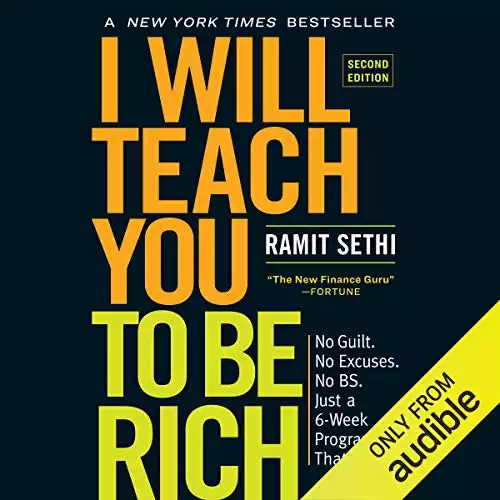Overview : I Will Teach You to Be Rich
- Book Title: I Will Teach You to Be Rich
- Author: Ramit Sethi
- Publication Date: March 2009
- price: $13.96
- Pages: 352
Overview of the Book
"I Will Teach You to Be Rich" by Ramit Sethi is a practical and engaging guide to personal finance, offering actionable advice on budgeting, saving, and investing for young professionals. The author simplifies financial concepts with humor and real-life examples to make wealth-building accessible.
Introduction
In the ever-evolving world of personal finance and investing, Ramit Sethi's "I Will Teach You to Be Rich" stands out as a beacon of practical wisdom. This comprehensive review delves into the core principles, strategies, and insights that make this book a must-read for anyone looking to master their financial future.
Book Summary
Sethi's book is structured as a six-week program, each week focusing on a crucial aspect of personal finance: 1. Credit Cards and Banking 2. Setting Up High-Interest Savings Accounts 3. Opening Investment Accounts 4. Conscious Spending 5. Automating Finances 6. Investing Strategies This step-by-step approach makes the daunting task of financial planning more manageable, especially for young professionals and those new to investing.
Analysis of Themes
Automation: The Key to Financial Success
One of the book's central themes is the power of automation in personal finance. Sethi argues that by setting up automatic transfers to savings, investments, and bill payments, individuals can overcome psychological barriers to saving and ensure consistent progress towards financial goals.
Conscious Spending
Sethi introduces the concept of "conscious spending," encouraging readers to spend lavishly on things they love while cutting costs mercilessly on non-priorities. This balanced approach to budgeting resonates with millennials and Gen Z, who value experiences and personal growth.
Investing for the Long Term
The book emphasizes the importance of long-term investing, particularly in low-cost index funds. Sethi's approach aligns with current market trends, which show the consistent outperformance of passive investing strategies over active management for most retail investors.
"The single most important factor to getting rich is getting started, not being the smartest person in the room." - Ramit Sethi
Writing Style
Sethi's writing is refreshingly direct and often humorous, making complex financial concepts accessible to a broad audience. His use of case studies and real-life examples helps readers connect with the material on a personal level.
Strengths and Weaknesses
Strengths:
- Actionable advice with step-by-step instructions - Focus on psychology and behavior change - Comprehensive coverage of essential financial topics - Engaging and relatable writing style
Weaknesses:
- Some advice may be less applicable to older readers or those with complex financial situations - Limited coverage of newer financial trends like cryptocurrencies - The assertive tone may not appeal to all readers
Comparison to Other Works
Compared to classics like "Rich Dad Poor Dad" by Robert Kiyosaki, Sethi's book offers more practical, step-by-step advice. While Kiyosaki focuses on mindset shifts, Sethi provides concrete actions readers can take immediately. In contrast to Dave Ramsey's "The Total Money Makeover," which emphasizes debt reduction and frugality, "I Will Teach You to Be Rich" takes a more balanced approach, encouraging strategic spending alongside saving and investing.
Market Analysis
Sethi's investment advice aligns well with current market trends. His emphasis on low-cost index funds is supported by data from reputable sources like Morningstar, which consistently shows the long-term outperformance of passive investing strategies for retail investors. The book's focus on automation and digital banking also reflects the ongoing shift towards fintech solutions in personal finance. According to a 2021 report by Plaid, 88% of Americans now use fintech apps to manage their finances, underscoring the relevance of Sethi's tech-savvy approach.
Highlights from I Will Teach You to Be Rich
- Personal finance fundamentals: Focuses on saving, investing, and budgeting for financial success.
- Automate finances: Advocates for automating savings and bills to reduce decision fatigue.
- Conscious spending: Encourages mindful spending on what matters most while cutting unnecessary costs.
- Investing strategies: Emphasizes long-term, low-cost investing for wealth-building, particularly through index funds.
- Credit cards and debt: Guides on using credit cards wisely and eliminating high-interest debt.
- Mindset shift: Focuses on taking control of finances with confidence and actionable steps.
Conclusion
"I Will Teach You to Be Rich" is a comprehensive guide that delivers on its promise to help readers take control of their finances. Sethi's blend of practical advice, psychological insights, and engaging writing makes the book a standout in the personal finance genre. While it may not cover every financial situation or the latest trends like cryptocurrencies, it offers a solid foundation for those starting their financial journey. The book's emphasis on automation, conscious spending, and long-term investing provides a framework that can lead to financial independence. Whether you're new to personal finance or looking for fresh insights, "I Will Teach You to Be Rich" is a worthwhile read that promises to transform your financial mindset and habits for the better.





